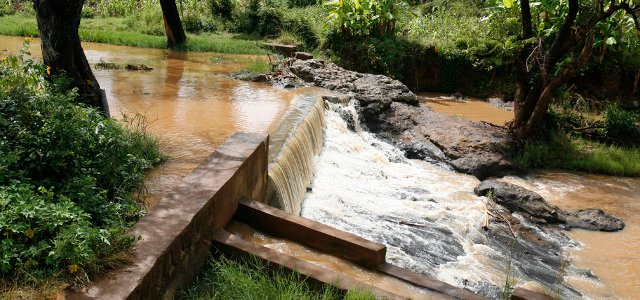For many rural Kenyans, it’s too expensive for households to pay to be connected to the national electricity grid. Some communities, who live near the right kinds of rivers are opting for a cheaper, more sustainable option: small scale hydro plants, to power lights, charge mobile phones, and pick up on the airwaves. South Africa-based science writer Leonie Joubert takes a closer look at a thriving model for community development.

Micro-hydro, like this example in Tungu-Kabiri, Kenya, can help provide rural communities with power – but long-term oriented management is needed. (Photo by Adam Hart-Davis)
For the average rural Kenyan, even those living within 600 meters of the nearest state-installed electricity transformer, it will cost them up to about US$ 350 to connect to the grid and electrify their homes. This is simply beyond their means.
But if a village is situated close to a natural water course that is feasible for a small hydro plant, and can raise some initial capital, rallying together in order to install a micro-hydro power plant is the answer. And since the first such project was piloted in the early 2000s, similar initiatives are popping up around the country, with varying levels of success.
The plants are small – usually no more than 1-megawatt – and can only drive low-demand appliances such as televisions and radios, or lights, or charge mobile phones. But for many it is a more affordable and sustainable way of meeting basic household electricity needs.
Mary Karumba, a doctoral researcher at the University of Cape Town’s Environmental Research Policy Unit (EPRU) in South Africa, explains:
The first micro-hydro project was piloted in the Tungu-Kabiri community, near Mount Kenya, about 185 km north of Nairobi,’ she says, ‘since then, many other communities have visited this site and seen how well it works, and have initiated similar schemes themselves.’
This is how the model works: a community that has access to a reliable river and a waterfall, needs to initiate the idea, raise the capital, contribute the land, and provide labour. Once they have raised the money to buy the turbines and other gear needed for the plant, they team up with the state or a development agency to do the installation. The highly specialised technicians will be brought in to help, but the community must do the building, and people from the community must step forward to be trained to operate and maintain the plant.
Each household then pays a pre-determined monthly fee that goes to the upkeep of the system; because the ongoing maintenance is done by these community volunteers, which helps keep the costs down.
The initial capital costs vary, depending on the size of the plant. It takes about a year from initiation to switching on the first lights. And the number of houses that can run on the mini-grid depends on the size of the plant. The Tungu-Kabiri pilot was connected to 200 households. Other plants might have just 38 or so.
Karumba is in the process of visiting 31 such community plants around her home country to compare their management methods, and understand why half of these have failed, and half have succeeded.
The limited power that comes from this grid is a ‘common pool resource’ which the community has to share,’ Karumba explains.
Each household can only draw so much power from the grid, using light appliances, and the community must draw up a list of rules about how to share this power. If one household plugs in too many appliances, and draws too much current, it trips the system and the whole grid collapses. The system can’t, for instance, support fridges, stoves or irons. Karumba is interested in seeing how communities cooperate, or not, in terms of sharing this resource.
Karumba’s research shows that there are sometimes other reasons why a project might fail: cable theft is common; turbines might break; money might be misappropriated; or the community might have a fall out or fails to pay maintenance fees.
One site that she’s focusing on, costs US$ 16 000 (about 1.6 million Kenyan shillings) for turbines, installation and connection. Around 72 households were on the grid initially. Today, however, only 38 are still part of the scheme.
In a country where almost 93 percent of the people in the countryside don’t have electricity in their homes, micro-hydro is an accessible way to fill the gap in meeting the country’s development agenda. And, according to Karumba, it’s a popular growing source of renewable energy in Kenya at the moment.
Leonie Joubert is a science writer and journalist, and currently works as a fellow with the University of Cape Town’s Environmental Humanities of the South, where she is looking at the political economy of the food system in her country.